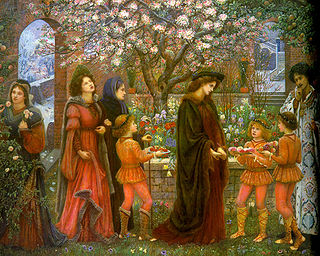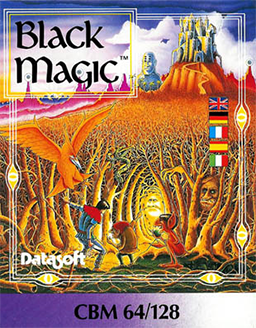
Oscar Zoroaster Phadrig Isaac Norman Henkle Emmannuel Ambroise Diggs is a fictional character in the Land of Oz created by American author L. Frank Baum. The character was further popularized by a stage play and several films, including the classic 1939 film and the 2013 prequel adaptation.

Nox is an action role-playing game developed and published by Westwood Studios and Electronic Arts in 2000 for Microsoft Windows. It details the story of Jack, a young man from Earth who is pulled into a high fantasy parallel universe and has to defeat the evil sorceress Hecubah and her army of necromancers to return home. Depending on the player's choice of character class at the beginning of the game, the game follows three largely different linear storylines, each leading to its unique ending. In the multiplayer, players can compete against each other in various game modes such as deathmatch and capture the flag, while the freely downloadable expansion pack NoxQuest added a cooperative multiplayer mode. The game was generally well received by critics and the media.
The magic in Dungeons & Dragons consists of the spells and magic systems used in the settings of the role-playing game Dungeons & Dragons (D&D). D&D defined the genre of fantasy role-playing games, and remains the most popular table-top version. Many of the original concepts have become widely used in the role-playing community across many different fictional worlds, as well as across all manner of popular media including books, board games, video games, and films.
Tibia is a multiplayer online role-playing game (MMORPG) released in 1997, developed and published by CipSoft. It is one of the earliest and longest-running MMORPGs, reaching its peak popularity in 2007. The game is free to play but players may pay to upgrade to a premium account. Tibia is a two-dimensional tile-based game set in a fantasy world with pixel art graphics and a top-down perspective.

Odyssey: The Compleat Apventure was a video game written by Robert Clardy and released by Synergistic Software in 1980. It was created for the Apple II platform and is considered one of the first microcomputer-based role-playing video games. The title was intentionally misspelled; Apventure is a reference to the Apple computer while "Compleat" is simply an Archaic spelling of the word "complete" meant to match the feel and setting of the game.
Magic: The Gathering Limited Edition is the first Magic: The Gathering card set. It premiered in a limited release at Origins Game Fair in 1993, with a general release that August. The initial print run of 2.6 million cards sold out quickly, and a new printing run was released in October 1993. These two runs are known as Limited Edition Alpha and Limited Edition Beta, or just Alpha and Beta for short. Although Alpha and Beta are referred to as different sets by some, officially they are the same set; Wizards of the Coast had expected that people wouldn't necessarily be able to tell the two press runs apart. Beta fixed a number of misprints and errors on cards. The printer accidentally used different corner rounding dies for the second run, resulting in Alpha cards being noticeably distinct in shape and appearance from Beta cards and all subsequent cards. The Beta printing also included a revised rulebook with a number of clarifications, although creator Richard Garfield's short fiction "Worzel's Tale" was removed to make room. The print run of Beta is given as 7.3 million or 7.8 million depending on the source. Despite the set's print run being about three times as big as Alpha's, Beta sold out as quickly as its predecessor.
The collectible card game Magic: The Gathering published seven expansion sets from 1993–1995, and one compilation set. These sets contained new cards that "expanded" on the base sets of Magic with their own mechanical theme and setting; these new cards could be played on their own, or mixed in with decks created from cards in the base sets. With Magic's runaway success, many of the printings of these early sets were too small to satisfy the rapidly growing fanbase. Cards from them became rare, hard to find, and expensive. It was not until Fallen Empires and Homelands that Wizards of the Coast was able to print enough cards to meet demand; additionally, Wizards of the Coast published Chronicles, a reprint set that helped fix many of the scarcity issues with the earliest sets.

The Gnome King of Oz (1927) is the twenty-first book in the Oz series created by L. Frank Baum and his successors, and the seventh by Ruth Plumly Thompson. Like nineteen of the twenty previous books, it was illustrated by John R. Neill. The book was followed by The Giant Horse of Oz (1928).

Magic Realm is a fantasy adventure board game designed by Richard Hamblen and published by Avalon Hill in 1979. Magic Realm is more complex than many wargames and is somewhat similar to a role-playing game. It can be played solitaire or with up to 16 players and game time can last 4 hours or more. The game board is a type of geomorphic mapboard constructed of large double-sided hexagon tiles, ensuring a wide variety of playing surfaces.
A character class is a fundamental part of the identity and nature of characters in the Dungeons & Dragons role-playing game. A character's capabilities, strengths, and weaknesses are largely defined by their class; choosing a class is one of the first steps a player takes to create a Dungeons & Dragons player character. A character's class affects a character's available skills and abilities. A well-rounded party of characters requires a variety of abilities offered by the classes found within the game.
The sorcerer is a playable character class in the Dungeons & Dragons fantasy role-playing game. A sorcerer is weak in melee combat, but a master of arcane magic, generally the most powerful form of D&D magic. Sorcerers' magical ability is innate rather than studied or bargained.
The wizard is one of the standard character class in the Dungeons & Dragons fantasy role-playing game. A wizard uses arcane magic, and is considered less effective in melee combat than other classes.

Lupin the 3rd: Treasure of the Sorcerer King is a stealth/action video game from Banpresto. It has an original story based on the manga and media franchise Lupin III. The gameplay relies heavily on stealth and the use of various disguises and is displayed from a third-person perspective.

A magician, also known as an archimage, mage, magus, magic-user, spellcaster, enchanter/enchantress, sorcerer/sorceress, warlock, witch, or wizard, is someone who uses or practices magic derived from supernatural, occult, or arcane sources. Magicians enjoy a rich history in mythology, legends, fiction, and folklore, and are common figures in works of fantasy, such as fantasy literature and role-playing games.

Black Magic is a multidirectional scrolling action-adventure game written for the Apple II by Peter Ward of Action Software and published by Datasoft in 1987. Commodore 64, ZX Spectrum, and Amstrad CPC versions were also released.

Cabal Online is a free-to-play, 3D massively multiplayer online role-playing game developed by South Korean company ESTsoft. Different localizations of the game exist for various countries and regions. Although free-to-play, the game makes use of the freemium business model by implementing an "Item Shop", both in-game and via web, allowing players to purchase special premium coins using real currency, in order to acquire exclusive game enhancements and features, useful items and assorted vanity content.
The Zendikar block is a Magic: The Gathering block consisting of the sets Zendikar, Worldwake, Rise of the Eldrazi. The eponymous setting is a vast, untamed wilderness, whose few bastions of civilization exist primarily for outfitting treasure-seeking expeditions to distant locales. Colossal ancient octahedral stones called "hedrons" float in the sky. A phenomenon known as "the Roil" causes frequent geological upheaval as it sweeps across the land. Unlike the previous two blocks, there is no multicolored theme. Instead, the themes Zendikar and Worldwake revolve around lands, and a theme of an adventure or quest. Rise of the Eldrazi, while part of the Zendikar block creatively and for the sake of constructed tournament rules, is unique mechanically and is designed to be drafted on its own. Drafts in the Zendikar block are either ZEN-ZEN-WWK or ROE-ROE-ROE.
The rules of Magic: The Gathering were originally developed by the game's creator, Richard Garfield, and accompanied the first version of the game in 1993. The rules of Magic have been changed frequently over the years by the manufacturer, Wizards of the Coast, mostly in minor ways. However, major rules overhauls have also been done a few times.

Defilers and Preservers: The Wizards of Athas is an accessory for the 2nd edition of the Advanced Dungeons & Dragons fantasy role-playing game.
Sorcerers of the Magic Kingdom was an interactive game found in the Magic Kingdom at the Walt Disney World Resort in Florida. The premise of the game is that Hades is trying to take over the Magic Kingdom and Merlin is recruiting park guests as new apprentices. The player, in the position of new apprentice sorcerers helps Merlin the Wizard thwart Hades' plan by attacking notorious Disney villains that can be found throughout the park's themed lands by using special spell cards.










